A $200 million project to improve bus service and change zoning through Southeast Portland and Gresham is in limbo after project managers realized that it wouldn’t actually make it faster to ride the bus.
“What we’re all finding is that having a BRT that is mostly sharing the roadway is extremely complicated.”
— Elizabeth Mros-O’Hara, Metro
The Powell-Division Transit and Development Project remains alive. Next week, regional agency Metro will start publicly discussing options to change it. Among them: splitting the project into two phases, changing the route, or dedicating parts of a travel lane to bus traffic on inner Powell Boulevard, 82nd Avenue or outer Division Street.
On Jan. 20, we reported that Metro, TriMet and the Oregon Department of Transportation were not considering a dedicated bus lane on 82nd Avenue, and that as a result the proposed “bus rapid transit” would actually travel more slowly there in 2035 than the #72 bus does today.
The next day, TriMet staff contacted Metro staff to warn them that this was also the case for the full length of the project.
Even using 2015 levels for auto traffic, riding the #4 from downtown Gresham to downtown Portland is 8 to 11 minutes faster than riding the proposed “bus rapid transit” would be, Metro spokesman Craig Beebe said Friday. This is in part because of the half-mile southward jog from Division to Powell and in part because without a bus lane, the buses (which will have a capacity of 86 or so) would be stuck behind cars.
“What we’re all finding is that having a BRT that is mostly sharing the roadway is extremely complicated,” said Metro planner Elizabeth Mros-O’Hara. “Going into it, I think we had the perception that we would be able to design our way out of those chokepoints.”
She added that the BRT plan would save time on certain shorter segments of the route, but that the lack of overall time savings made the transit portion of the project “not very compelling.”

(Image via TriMet)
In any case, Beebe said the information may delay the project by years.
After the Jan. 21 memo, Metro canceled a planned Feb. 1 meeting where the project staff had been planning to ask the project’s steering committee for a final sign-off on the route. That conversation has been postponed until March 28, the steering committee will meet to consider various major departures from the previous plan.
“It’s the first type of BRT in the region; we want to get it right, and we want to get something built that makes people’s lives better,” Beebe said. “I think it’s good when a project really takes some more time to really explore what the options are.”
Six alternative options for the project
Part of the reason to change course on the project is that the Powell-Division project has been hoping to get dollar-for-dollar matching grants from the federal Small Starts program. That could bring in up to $100 million.
But getting that federal grant requires the Powell-Division project to be more attractive than other grant applicants around the country. And Beebe said that a project that wouldn’t generally make transit faster isn’t likely to get federal transit funding.
Instead, the project faces several options. Here are the ones being discussed so far, as described in a document that was circulated to project steering committee members this month:
The project could scrap its aspiration for federal funding and just improve bus service on the #4 and the #9.
The project could save some time by further reducing the number of bus stations along the route, though this wouldn’t save enough time to make buses travel faster than they do today.
The project could spend vastly more money or political capital and create dedicated bus lanes either by knocking down buildings along the corridor or by dedicating existing travel lanes to buses only. A few notes on this scenario:
• The project has never examined the possibility of a freight-and-bus-only lane, so that’s not considered here.
• Though this memo lists “bicycle” traffic as the first victim of “major impacts” from repurposed lane scenario, Metro says this phrase refers to the fact that people biking north and south would get longer red signal phases and to the difficulty of fitting bus lanes into the corner of 82nd and Division.
• The actual primary impact of this scenario, of course, would be that it would increase auto travel times.
The project could create bus lanes on a few key portions of the route. This, too, would be far more expensive and/or politically difficult.
The project could break into two phases (each of which might go in for its own Small Starts grant) first making changes to Division east of 82nd and then making changes to 82nd and Powell west of 82nd.
The project could break into two phases, first making improvements to Division and then making improvements to Powell.
The direction of the project from here will be decided by its steering committee, which includes citizen volunteers, advocates and public staffers.
“We are definitely not coming to the table with the answer,” Mros-O’Hara said.
— Michael Andersen, (503) 333-7824 – michael@bikeportland.org
BikePortland can’t survive without subscribers. It’s just $10 per month and you can sign up in a few minutes.
The post ‘Rapid’ bus plan on Powell-Division stalls after it turns out not to be rapid appeared first on BikePortland.org.
from Front Page – BikePortland.org http://ift.tt/1UndNhK
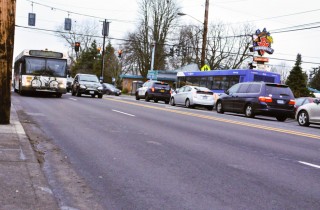
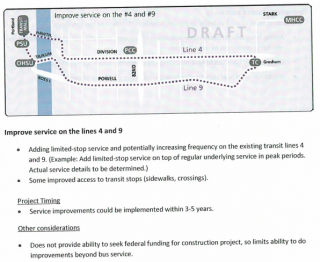
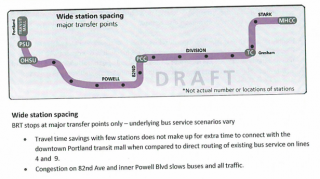
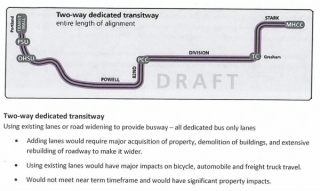
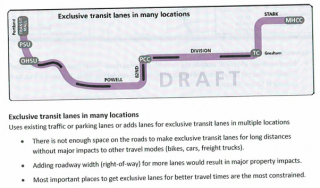
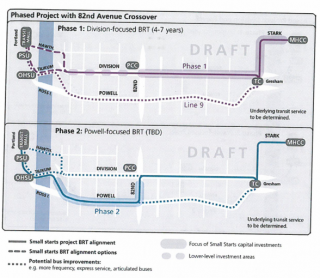
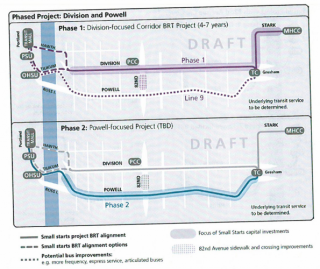
No comments:
Post a Comment